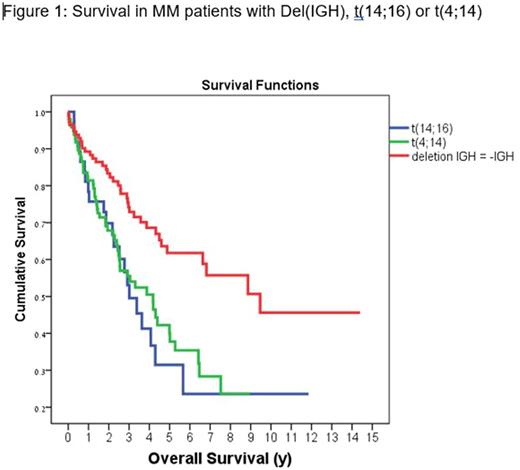Abstract
Introduction
Multiple myeloma (MM) is a malignancy of plasma cells characterized by a large variety of chromosomal abnormalities (CAs). Translocations involving the immunoglobulin heavy-chain gene (IGH) located on 14q32, including t(4;14), t(14;16), and t(14;20) are among the most important CAs associated with unfavorable outcomes. Several types of IGH gene deletions have been reported in approximately 20% of MM patients. However, the prognosis of this group of patients has not been fully elucidated. The current study analyzed the prognostic significance of monoallelic deletion of the whole locus of IGH [del(IGH)] compared to t(4;14) and t(14;16) in a large cohort of MM patients.
Methods
The clinical (age, gender, staging) and laboratory data at diagnosis, and overall survival (OS) of 255 newly diagnosed MM patients carrying the CAs del(IGH), t(4;14) and t(14;16) were retrospectively analyzed. Bone marrow samples were examined by combined morphological and sequential I-FISH analyses. All del(IGH) that were found using the LSI IGH dual-color, break apart rearrangement probe were confirmed by LSI IGH/FGFR3 and LSI IGH/MAF dual color, dual fusion translocation probes (Vysis, Downers Grove, IL).
All bone marrow samples from patients with MM were harvested and analyzed as part of routine clinical evaluation. The study was approved by the Institutional Helsinki Committee and the Israel Ministry of Health.
Statistical Analysis: Differences between groups were tested with ANOVA, Kruskal-Wallis test and Pearson's chi-squared. OS analysis was performed using Log Rank test.
Results
Among 255 patients, 117 (45.8%) had del(IGH), 99 (38.8%) had translocation t(4;14), and 39 (15.3%) had t(14;16). Mean age was 61.6 ± 11.6 years. The groups did not differ significantly in age, gender, LDH levels or ISS staging.
As can be seen in Figure 1, patients in the del(IGH) group had significantly higher estimated median OS (9.466 years) compared to the t(14;16) (3.014 years, p=0.002) and t(4;14) (4.184 years, p=0.001) groups, respectively.
In our cohort, MM patients had 0 to 4 CAs in addition to their group-defining CA, with most having 1-2 additional CAs. Patients in the del(IGH) group, had significantly fewer additional CAs than the other two groups did (1.58, 2.3 and 2.13 in the del(IGH), t(14;16) and t(4;14) groups, respectively, p<0.0001).
MM patients with delp53, del 1p, single gain1q, or multiple 1q gains, and del 16q in addition to del(IGH) had markedly reduced OS compared to del(IGH) alone.
Conclusions
In our cohort of newly diagnosed MM patients, monoallelic deletion of the whole locus of the IGH gene had significantly better OS compared to patients with translocation t(14;16) or t(4;14). Patients in the del(IGH) group, had fewer additional CAs than the other two groups did, which might partially explain the OS advantage. Additional studies are needed to better understand the survival advantage of this group of patients.
No relevant conflicts of interest to declare.
Author notes
Asterisk with author names denotes non-ASH members.


